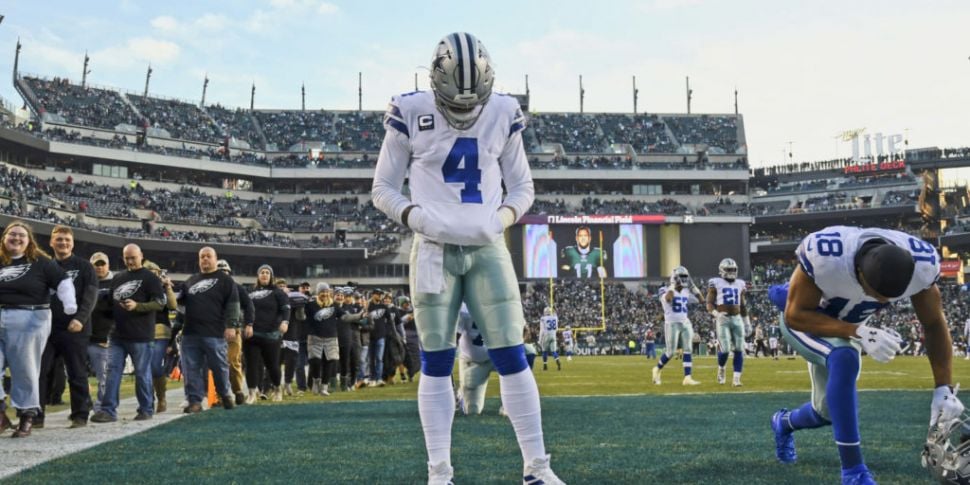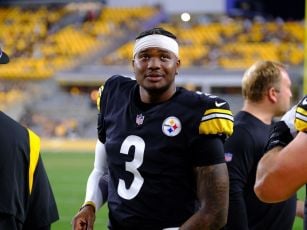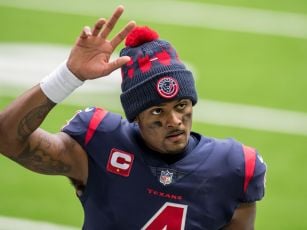The biggest NFL storyline entering free agency is Dak Prescott. He's very unlikely to leave the Dallas Cowboys but the two sides are yet to agree on a figure for his salary moving forward.
Dak Prescott had some ugly misses last season. In a contract year, the Dallas Cowboys starting quarterback missed more routine throws than he had in any previous year. Many of those came in the Cowboys' biggest game of the season, a loss against the Philadelphia Eagles. That loss confirmed Dallas wouldn't make the playoffs. A deep playoff push would have forced the Cowboys to make him the highest-paid quarterback in the league this offseason.
Last offseason, Prescott reportedly rejected a $33 million per year deal.
$33 million would rank as the fifth-highest salary in the league this year. Prescott would have earned $1 million more than Carson Wentz had he signed that contract. But that's not how the quarterback market works. The highest-paid quarterback in the league is not the best quarterback in the league. The highest-paid quarterback in the league is more likely to be a marginally effective starter whose contract most recently came up. That's how Matthew Stafford, Kirk Cousins, Jimmy Garroppolo, Derek Carr and Jared Goff have all reset the market in recent years.
Goff will make $33.5 million this year. Injured, 38-year old Ben Roethlisberger will make $34 million this year. Russell Wilson is the highest-paid quarterback in the league at $35 million. That's the bottom line for Prescott's negotiations, he has been a hugely effective and hugely successful starting quarterback for four seasons now. His leverage is better than that of a $33 million-per-year player and his value only grows the further away we get from his extension as more quarterbacks sign new deals. Especially when Aaron Rodgers and Patrick Mahomes are about to sign new deals.
Furthermore, being the quarterback of the Cowboys is the most prominent position in all of sports and he has been severely underpaid for his whole career because of the rookie wage scale. Forbes estimates the Cowboys value is $5 billion with an operating income of $365 million per year. That makes them the most valuable sports franchise in the world.
Jerry Jones, the Cowboys owner, is worth $8 billion. The Cowboys' only concern is the salary cap, they want to retain Prescott and Amari Cooper without spending all their cap space. That's why Stephen Jones, Jerry's son who runs the team, publicly pressured Prescott into taking a team-friendly deal last offseason. It's also why Emmitt Smith, a Cowboys legend who famously held out for more money, did the same last month. Those public comments are negotiating tactics.
The Cowboys are trying to use fan pressure to make Prescott the bad guy for seeking out his market value. Prescott has been playing football in a professional environment for eight years, dating back to his first season at Mississippi State. At a position where starters average $20 million per year, Prescott has career earnings of $4.8 million. His cap hits have been minimal. Yet the Cowboys have never maximized their spending to build the best possible team. They purposely didn't sign outside free agents, most notably Earl Thomas last offseason, claiming they needed to save money to pay their stars.
They've paid Ezekiel Elliott, Demarcus Lawrence and Jaylon Smith. And they still have $77 million in cap space, fifth-most in the league.
Prescott has every right to hold out for a $40 million salary.
The Cowboys will use those aforementioned ugly misses in negotiations against him. They'll use the fact the Cowboys didn't make the playoffs last season as a reason not to pay him. They'll try to squash his salary down as much as possible before free agency opens, with the franchise tag lingering if they can't agree to a deal before the deadline. But those ugly misses, while egregious, weren't reflective of Prescott's overall play. Last season was actually a strong argument for paying him.
Prescott had more egregious misses last season because he had more easy throws than ever before. New offensive coordinator Kellen Moore brought in a more expansive passing game. Since departed head coach Jason Garrett had previously prioritized the running game at the expense of the passing game with Moore's predecessor Scott Linehan. Garrett was the primary reason the Cowboys didn't make the playoffs. He constantly made the wrong decision in important situations and pulled the passing game back toward his identity as the season wore on.
Being the Cowboys quarterback means being blamed for everything when anything goes wrong. It means you face far more scrutiny than anyone else in the sport. Just ask Tony Romo, a famously divisive figure during his career despite being a consistently elite player. So while Prescott was elevating the team around him and Garrett was anchoring it down as much as possible, it was still popular to paint Prescott as part of the problem.
For the first three years of his career, Prescott had to be great for the offence to be average. Over the first half of last season, the Cowboys offence looked nothing like it did previously. Moore's influence on the scheme took the pressure off of Prescott.
While not being asked to make impossible throws every drive, Prescott's depth-adjusted accuracy leapt to 71.3 percent over the first eight weeks of the season. It dropped to 66.9 percent over the remainder of the regular season as Garrett's philosophy returned to prominence in play-calling. Prescott was 68.9 percent accurate for the full season. To put that into perspective, Andrew Luck was the most accurate quarterback in the NFL in 2018 at 67.9 percent and the league average that year was 56.7 percent.
His misses were wild but they were infrequent. He wasn't helped by his receivers, who dropped a monumental 51 passes that would have gained at least 507 yards. His teammates turned an accurate throw into an incompletion once every 12 attempts.
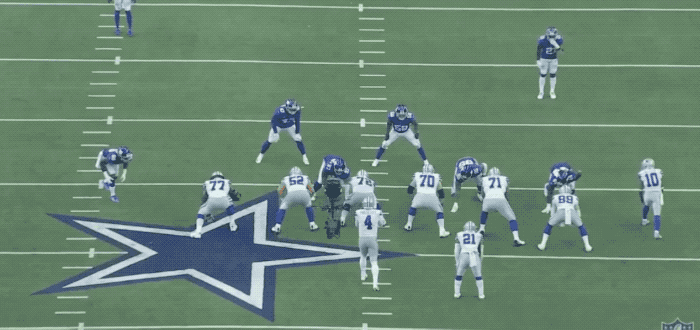
The foundation of Prescott's skill set is his intelligence. In a spread offence, he has more responsibility because the design of the offence puts more receivers on the field. More receivers means more routes which means more options. Too many of the Cowboys play designs in previous years have relied on one or two receivers to get open without any help from teammates. That forced Prescott to throw into very tight windows or take a negative play.
In the above play from Week 1, Tavon Austin is wide open because of the play design. This is an RPO. There are four receivers running routes and the fifth eligible receiver is Ezekiel Elliott. While handing the ball off to Elliott, Prescott is reading the linebacker. Because the linebacker doesn't move to his left, Prescott pulls out to pass instead of giving it to Elliott. Had the linebacker taken a step back or towards Austin, he would have given the ball to Elliott.
The best offences in the league generally spread the defence out and give the quarterback options. This leads to easier throws for smart quarterbacks. Since Prescott is very smart, he excels in this style of attack.
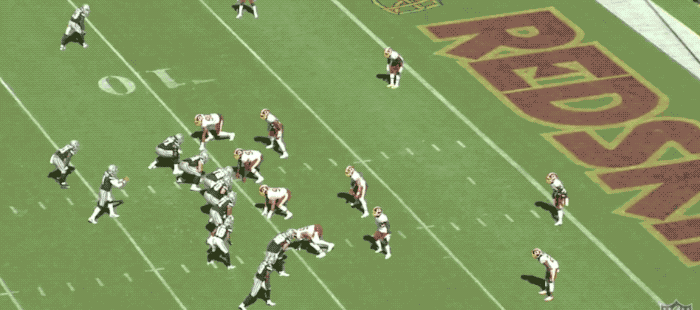
Prescott was 84.1 percent accurate on short throws. He hit 254 of 302 attempts in the 1-10 yard range. This was one of his most impressive plays of the year. It's a cerebral play so it doesn't overtly stand out as anything spectacular. What's spectacular is the speed of his mental processing and the precision of his throw. Prescott reads the safety to his left when the ball is snapped. That defender stays where he is, so he knows the safety on the opposite side is staying on that side of the field too. Prescott also knows that he only has two receivers working left, with three working on the right side.
One of those three is Amari Cooper, Prescott's best receiver. Moore put Cooper in a tight bunch, preventing the Washington defense from playing press-man coverage. This meant that Cooper was covered by the deep safety when the play began. Prescott's eyes opened left before immediately snapping back to the right. The timing of his actions is important because the deep safety makes a great break on Cooper's route. Prescott recognizes the safety's movement so he purposely places the ball on Cooper's outside shoulder instead of throwing the ball directly to him.
He's purposely leading Cooper to space, allowing his receiver to go into the endzone untouched while taking the defender completely out of the play.
Prescott is incredibly intelligent but has had the impact of his brain minimized in the past. A startling number of the Cowboys' big plays in the passing game over the first three seasons of his career came after one of his audibles. When the offence has two tight ends or a fullback on the field, the quarterback has fewer options to change the play at the line of scrimmage compared to when he has three or more receivers. As a spread quarterback, Prescott's brain has a greater impact on games.
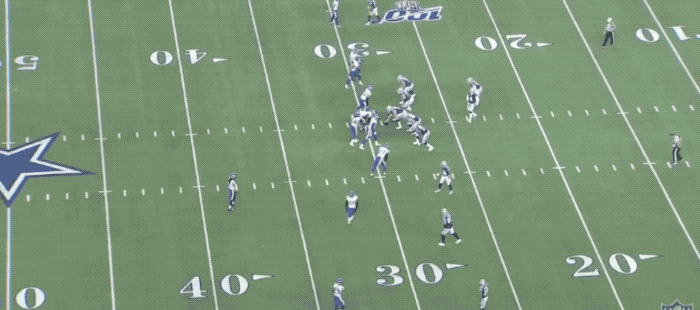
On this play against the Minnesota Vikings, Prescott audibles into a play based on how the defence lines up. Then Harrison Smith, the left-sided safety, drops deep from his original position at the line of scrimmage. Prescott changes the play again to counter that before throwing into the space Smith vacated for the big gain. It's extremely rare for a quarterback to audible twice on the same play, Prescott does it more than anyone.
He followed those audibles up with a perfect throw while being hit as he released the ball.
So much of what Prescott does well is missed unless you're specifically watching for it. He makes plays that shouldn't work by showing off perfect technique and intelligence. One of the most important traits for a quarterback is his timing. Some coaches can build offences that mean the quarterback's timing doesn't need to be consistently good for them to be productive. Prescott has never played in one of those offences.
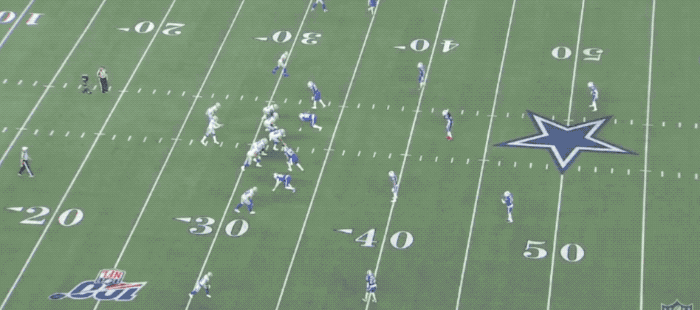
This play is an example of Prescott making a high-level throw that looks routine. The first note is where the ball is thrown from and where it arrives. Prescott is on the right hash mark and his receiver is by the left sideline, this is a long throw. The second note from this angle is when Prescott releases the ball. The gif slows down as he begins his throwing motion, at which point the receiver is still two steps away from entering the break in his route. This is an anticipation throw. Prescott throws them a lot.
An anticipation throw is a throw where the quarterback envisions where his receiver is going to be and puts the ball there before he gets there. On this play, had Prescott waited to see his receiver open before releasing the ball, he would have been intercepted.

This is the endzone angle of the same play. It gives us a greater appreciation of the distance the ball covered, the precision of Prescott's throw and the threat of the cornerback in tight coverage. While making perfect timing throws and understanding how to diagnose coverages both before and after the snap to make throws that appear routine, Prescott is also capable of the spectacular.
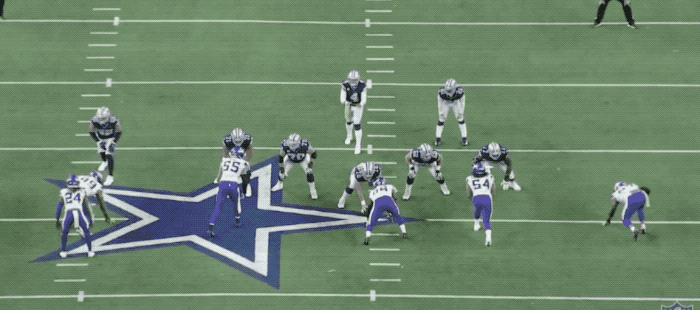
Because he does not flinch against pressure or in condensed pockets, Prescott is an outstanding third down passer. He's capable of consistently converting first downs from behind the down-and-distance by hitting tight windows just before the pass rush takes him out. This throw against the Minnesota Vikings comes on third down when Prescott has to hold the ball to let the routes downfield develop, that puts him at the mercy of the Vikings dangerous pass rush. Even while holding the ball for that amount of time, he still had to throw the ball over the defensive back in tight coverage to Amari Cooper.
This pass needed to be perfect to allow Cooper to catch it in bounds. His margin for error here is non-existent. Any overthrow is an incompletion, any overthrow is an interception.
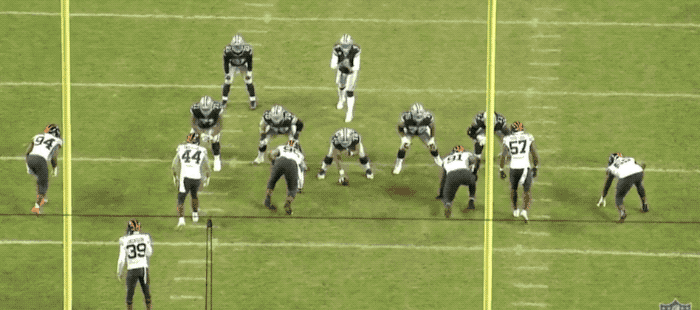
Prescott has an above-average arm, not a great arm. Yet he has been the best quarterback in the league at hitting deep sideline throws since his rookie season. His ability to manipulate the trajectory of the ball to drop it over tight coverage deep downfield is worthy of any superlative. This touchdown throw to Amari Cooper can only be defended if the defensive back dominates Cooper so much early in the route that the receiver is pushed out over the sideline. It's great coverage on an impossible assignment.
Last season, Prescott was accurate on 24 of 41 deep sideline attempts, 58.5 percent. Fellow free agent quarterback Tom Brady was accurate on 15 of 34 attempts, 44.1 percent.
Five drops curtailed Prescott's production on those plays.
In a league where Nick Foles gets $88 million for fluking his way to a Super Bowl, it would be an injustice if Dak Prescott didn't become the next highest-paid player in the league. At the very least, Prescott needs to be compensated for all the criticism he's going to take now that the Cowboys have hired Jason Garrett 2.0 in Mike McCarthy. The former Green Bay Packers head coach handcuffed Aaron Rodgers the same way Garrett did Prescott.
McCarthy's hire suggests little has changed in Dallas. That means we can guesstimate that the Cowboys will reach a deal with Prescott at the last possible moment, the same way they did with Elliott last offseason.
Prescott isn't Patrick Mahomes or Aaron Rodgers, but he's one of the league's best quarterbacks and he's entering his prime. This isn't paying Kirk Cousins, Derek Carr or Jared Goff. He's far superior to the crowded tier of mediocre starting quarterbacks in the NFL. Once Mahomes and Rodgers sign $40 million deals, the Cowboys keeping Prescott for anything below that will be good value. Quarterback contracts will only continue to rise as bad franchises exercise their desperation. Locking up Prescott for the next 5-6 years will give the Cowboys certainty that most teams will envy.
Download the brand new OffTheBall App in the Play Store & App Store right now! We've got you covered!
Subscribe to OffTheBall's YouTube channel for more videos, like us on Facebook or follow us on Twitter for the latest sporting news and content.

